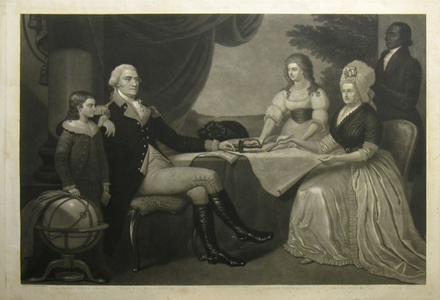| Method | Mezzotint |
| Artist | J. Sartain after Edward Savage |
| Published | Published by Wm. Smith , 706 South 3d Street, Philad.a. c. 1840 |
| Dimensions | Image 410 x 600 mm, Sheet 471 x 670 mm. |
| Notes |
Inscribed below image with the names of the depicted figures: Geo. Wash.n Parke Custis; Gen.l Geo. Washington; Eleanor Parke Custis; Martha Washington and William Lee. John Sartain (1808-1897) was born in England and apprenticed as an engraver. Seeking to establish himself as a printmaker, he emigrated in 1830 to Philadelphia, where he remained for the rest of his life. Sartain has been called the 'father of mezzotint engraving in the United States'. As a painter in oil and watercolor as well as a printmaker, he was involved in art education, serving as a director of the Pennsylvania Academy of Fine Arts and on the board of the Philadelphia School of Design for Women, now Moore College of Art and Design. Sartain also served as art director for the Centennial Exposition of 1876. When George Washington married Martha Custis, she was a wealthy widow. In 1781 the couple adopted her orphaned grandchildren, Eleanor and George. Edward Savage's picture is the only group portrait developed from life sittings of America's first "First Family." In 1789-1790 the Washingtons posed for studies in New York City. From 1791 to 1794 Savage lived in London and did not resume work on the oil painting until he returned to the United States. On 20 February 1796 he advertised The Washington Family as the main attraction at the Columbian Gallery, his private museum in Philadelphia, where visitors could see "The President and Family, the full size of life." Engravings after this image earned the artist a fortune, as did the entrance fees collected from his frequent exhibitions of the canvas. Savage's catalogue states that Washington's uniform and the papers beneath his hand allude to his "Military Character" and "Presidentship". With a map of the new District of Columbia in front of her, Martha is "pointing with her fan to the grand avenue" now known as Pennsylvania Avenue. Because Savage had never seen Mount Vernon, he added imaginary elements such as marble columns and a liveried servant. The formal symmetry derives from British portraits in the Grand Manner, but the stiff postures and awkward anatomy reveal Savage's limited experience. Condition: Trimmed within the plate at bottom of sheet, lareg diagonal crease to top left of sheet and image, light foxing to margins and inscription space. |
| Framing | unmounted |
| Price | £550.00 |
| Stock ID | 24887 |

